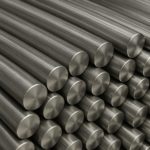STEELS
Base alloy and additional elements

Steels are a family of alloys characterised by the varying carbon content added to iron. Additional elements may be incorporated into the alloy to provide steel with a wide range of mechanical and physical properties.
The carbon content determines the hardness of the alloy. We refer to soft or extra-soft steels for low carbon content (0.20 – 0.40%) and hard or extra-hard steels for high carbon content (0.40 – 0.70%). Although steel is an alloy, we refer to non-alloyed steel when it contains only iron and carbon.
A large number of elements can be added to iron and carbon. Chromium, nickel, tungsten, titanium, aluminium, vanadium, phosphorus, or silicon are the main ones. Depending on their concentration, some elements will boost corrosion resistance, while others will enhance machinability, hardenability, and other properties.
Different steels
By varying the carbon content in steel, the possible added elements and their quantities, one can obtain an extraordinary range of steels with highly varied and multiple specificities. Therefore, steels are classified into four major families: Carbon steels (non-alloyed steels), low-alloyed steels, high-alloyed steels (stainless steels), and high-speed steels (tool steels).
Non-alloyed steels are primarily used in construction and, nowadays, have almost no application in horology.
Low-alloyed steels are found in many movement components. Depending on the nature of the alloy, it is possible to enhance hardenability, hardness, elasticity, etc., by adjusting the composition and content of the alloy.
Watchmakers use steel for components subject to significant mechanical stresses, such as levers, axles, springs, gears, pinions, and so on, where mechanical functions, elasticity, and friction are critical.
In horology, high-alloyed steels are mainly found in the watch’s external components (case, bracelet, etc.). To be classified in this category, a steel must contain an alloying element with a content above 5%. Chromium and nickel are most commonly present at such levels. These two elements make it possible to obtain stainless steels. For the external components (cases, bracelets), watchmakers particularly favour stainless steel referred to as 316L. This steel has low carbon content (0.03%) for 16-19% chromium and 10-13% nickel, along with six other elements (Si, Mn, P, S, Mo, and N), which confer, among other things, its remarkable corrosion resistance.
Two other high-alloyed steels are of paramount importance to watchmakers: Invar and Elinvar. Patented by Charles-Edouard Guillaume, these are alloys with a nickel content of 36% and 0.4% carbon respectively. As their names suggest, these alloys were developed to achieve the lowest possible coefficient of thermal expansion (Invar – invariable) and as much elasticity as possible (Elinvar – elastic and invariable). These are ideal and necessary properties in the manufacture of balance springs to achieve optimal chronometry.
Thermal treatment
The crystalline structure of steels changes as the temperature increases and decreases. The extent of these modifications depends on the carbon content. Thus, the crystalline structure of certain steels can be modified through heat treatments (quenching, tempering, annealing) or thermodynamic methods (rolling, forging) to harden or soften the material.
Fields of application and specificities
By adjusting the carbon content, the choice and content of alloying elements, and possible heat or thermodynamic treatments, one can obtain the largest family of alloys with the broadest range of specificities and applications.
Steels are generally magnetic and electrically conductive. In addition to machining and stamping, they are suitable for electro-erosion and various surface treatments.
Three ferrous products can be considered: iron, cast iron, and steel.
Historically, the Iron Age began around 1200 BC, varying by culture.
The Chinese produced the first cast iron around 500 BC. They simultaneously created the first steels by recarburising iron in contact with charcoal. In antiquity, combustion gases were added to charcoal to recarburise iron and improve its hardness (for the cutting edges of tools and weapons).
The theorisation of alloys began in the 18th century, but it was not until the mid-19th century that science enabled the understanding of alloys and the production of quality steels.
In 1855, Henry Bessemer patented a low-cost steel production process that would spark the industrial revolution. At the beginning of the 20th century, Bessemer’s air converter process was replaced by much more precise, efficient, and economical gas (oxygen) converters.
Since then, materials science has continuously evolved. The nature and composition of alloys and steel production processes are continually advancing to produce materials that are ever more suitable and efficient.
In watchmaking, we can distinguish two main areas of application of steels: the movement and the exterior (cases, bracelets).
The movement
In the movement, steel is valued for its hardness, elasticity, and tribological properties. It is commonly found in all mechanical functions (winding mechanism, time setting, complications, etc.). These often include levers, springs, or fastening elements. Axles, pinions, certain intermediate wheels, or the plate of the escapement wheel or a lever are typically made of steel. Traditionally, hairsprings are made from Elinvar, an alloy prized for its elasticity and very low thermal expansion coefficient, in both horology and metrology.
External parts
Stainless steels are used for the external components of a watch. Here, the focus is on corrosion resistance, biocompatibility, and the quality of possible finishes (polishing, satin finishing, bead blasting, etc.).
Production methods
Steel is compatible with most manufacturing methods: machining, stamping, electrical discharge machining (EDM), and laser processing.
